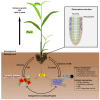Plant Growth-Promoting Bacteria as an Emerging Tool to Manage Bacterial Rice Pathogens
- PMID: 33810209
- PMCID: PMC8065915
- DOI: 10.3390/microorganisms9040682
Plant Growth-Promoting Bacteria as an Emerging Tool to Manage Bacterial Rice Pathogens
Abstract
As a major food crop, rice (Oryza sativa) is produced and consumed by nearly 90% of the population in Asia with less than 9% produced outside Asia. Hence, reports on large scale grain losses were alarming and resulted in a heightened awareness on the importance of rice plants' health and increased interest against phytopathogens in rice. To serve this interest, this review will provide a summary on bacterial rice pathogens, which can potentially be controlled by plant growth-promoting bacteria (PGPB). Additionally, this review highlights PGPB-mediated functional traits, including biocontrol of bacterial rice pathogens and enhancement of rice plant's growth. Currently, a plethora of recent studies address the use of PGPB to combat bacterial rice pathogens in an attempt to replace existing methods of chemical fertilizers and pesticides that often lead to environmental pollutions. As a tool to combat bacterial rice pathogens, PGPB presented itself as a promising alternative in improving rice plants' health and simultaneously controlling bacterial rice pathogens in vitro and in the field/greenhouse studies. PGPB, such as Bacillus, Pseudomonas, Enterobacter, Streptomyces, are now very well-known. Applications of PGPB as bioformulations are found to be effective in improving rice productivity and provide an eco-friendly alternative to agroecosystems.
Keywords: Oryza sativa; bacterial rice pathogens; biocontrol agents; bioformulations; plant growth-promoting bacteria.
Conflict of interest statement
The authors declare no conflict of interest.
Figures

Similar articles
-
Predatory activity of Acanthamoeba sp genotype T4 on different plant growth-promoting bacteria and their combined effect on rice seedling growth.Eur J Protistol. 2022 Feb;82:125858. doi: 10.1016/j.ejop.2021.125858. Epub 2021 Dec 7. Eur J Protistol. 2022. PMID: 34922137
-
Plant Growth-Promoting Activity of Bacteria Isolated from Asian Rice (Oryza sativa L.) Depends on Rice Genotype.Microbiol Spectr. 2022 Aug 31;10(4):e0278721. doi: 10.1128/spectrum.02787-21. Epub 2022 Jul 11. Microbiol Spectr. 2022. PMID: 35862989 Free PMC article.
-
Promising bacterial genera for agricultural practices: An insight on plant growth-promoting properties and microbial safety aspects.Sci Total Environ. 2019 Sep 10;682:779-799. doi: 10.1016/j.scitotenv.2019.04.225. Epub 2019 Apr 19. Sci Total Environ. 2019. PMID: 31146074 Review.
-
Streptomyces-mediated growth enhancement and Bacterial Panicle Blight disease suppression in rice plants under greenhouse conditions.J Biotechnol. 2022 Nov 20;359:148-160. doi: 10.1016/j.jbiotec.2022.09.018. Epub 2022 Sep 28. J Biotechnol. 2022. PMID: 36181924
-
Microorganisms in biological control strategies to manage microbial plant pathogens: a review.Arch Microbiol. 2022 Oct 10;204(11):666. doi: 10.1007/s00203-022-03279-w. Arch Microbiol. 2022. PMID: 36214917 Review.
Cited by
-
Application of Bacterial Endophytes to Control Bacterial Leaf Blight Disease and Promote Rice Growth.Plant Pathol J. 2022 Oct;38(5):490-502. doi: 10.5423/PPJ.OA.01.2022.0014. Epub 2022 Oct 1. Plant Pathol J. 2022. PMID: 36221921 Free PMC article.
-
An Isolated Arthrobacter sp. Enhances Rice (Oryza sativa L.) Plant Growth.Microorganisms. 2022 Jun 9;10(6):1187. doi: 10.3390/microorganisms10061187. Microorganisms. 2022. PMID: 35744704 Free PMC article.
-
Multiple Functions of MiRNAs in Brassica napus L.Life (Basel). 2022 Nov 7;12(11):1811. doi: 10.3390/life12111811. Life (Basel). 2022. PMID: 36362967 Free PMC article. Review.
-
Heterologous Production of Antimicrobial Peptides: Notes to Consider.Protein J. 2024 Apr;43(2):129-158. doi: 10.1007/s10930-023-10174-w. Epub 2024 Jan 5. Protein J. 2024. PMID: 38180586
-
Streptomyces as a promising biological control agents for plant pathogens.Front Microbiol. 2023 Nov 14;14:1285543. doi: 10.3389/fmicb.2023.1285543. eCollection 2023. Front Microbiol. 2023. PMID: 38033592 Free PMC article. Review.
References
-
- Firdaus R.B.R., Leong Tan M., Rahmat S.R., Senevi Gunaratne M. Paddy, rice and food security in Malaysia: A review of climate change impacts. Cogent Soc. Sci. 2020;6:1818373. doi: 10.1080/23311886.2020.1818373. - DOI
-
- Saha S., Garg R., Biswas A., Rai A.B. Bacterial diseases of rice: An overview. J. Pure Appl. Microbiol. 2015;9:725–736.
-
- Azizi M.M.F., Ismail S.I., Ina-Salwany M.Y., Hata E.M., Zulperi D. The emergence of Pantoea species as a future threat to global rice production. J. Plant. Prot. Res. 2020;60:1–9.
Publication types
Grants and funding
LinkOut - more resources
Full Text Sources
Other Literature Sources
Research Materials

